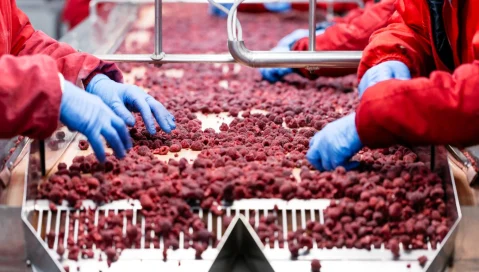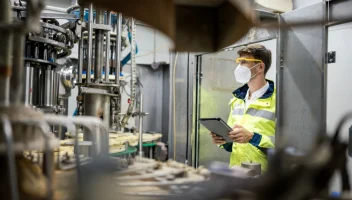Forging a More Resilient Fresh Produce Supply Chain with Food ERP Solutions
Forging a More Resilient Fresh Produce Supply Chain with Food ERP Solutions
Forging a More Resilient Fresh Produce Supply Chain with Food ERP Solutions
17 Aug 2021
Jack Payne
While some parts of the world are beginning a cautious return to “normal” in the wake of the COVID-19 pandemic, other areas are still seeing alarming numbers of cases among the population. After more than a year of dealing with insufficient supply, shipping restrictions and unpredictable dips and spikes in demand, fresh produce businesses like yours are trying to navigate a potentially volatile marketplace with the pragmatic mindset that it requires.
The vulnerabilities of fresh produce supply chains were made evident in the spring of 2020, when a combination of lockdowns, labor shortages, transportation delays and panic buying caused a crisis in the sector. Industry leaders learned much from the struggles, and it’s clear that in the face of lingering uncertainty, improvements must be made and new strategies implemented.
Here, we’ll examine the causes behind the various issues that resulted from the disruptions of the past year and a half, as well as the lessons learned from these predicaments. In particular, we’ll explore how changes in methodology and adoption of fresh produce enterprise resource planning (ERP) technology can protect your business’s interests going forward.
Lack of Supply and Evolving the Just-in-Time Model
Since the outset of the pandemic, produce sections of grocery stores have at times been bare due to a combination of factors. Transportation and shipping interruptions caused by nationwide stay-at-home orders meant that fewer fresh goods were reaching retail, and stockpiling and panic buying on the part of consumers quickly demolished the little supply that was available.
Obviously, both of these root causes were out of the hands of businesses like yours, and they came about suddenly, with little to no prior warning. The situation did make clear, though, that the current “just-in-time” model of food distribution needs to evolve so that the industry can be better prepared in the future.
Under the commonly accepted just-in-time concept of the past, the amount of fresh produce delivered to retail outlets were so finely tuned to the expected buying patterns of consumers so as to allow for little to no deviation from the norm. This kept wastage and storage costs down, but provided no tolerance for halted deliveries and overnight surges in demand like those that occurred.
While solid demand forecasting from a food ERP solution is a must for fresh produce companies that want to optimize their levels of production and align output with projected sales, it is perhaps the agility that these systems offer that is more important when compensating for abrupt change. As cross-functional platforms that provide real-time insights based on your latest data, you can move quickly to scale up or down according to the circumstances—quickly identifying any bottlenecks.
Shifts in Demand and Securing New Outlets
The spike in retail demand seen at the outset of the pandemic was accompanied by a steep drop off in restaurant and foodservice sales for fresh produce companies. With many eateries, cafeterias and other meal service providers either closed entirely or operating at a significantly reduced capacity, they simply didn’t need near as much in terms of ingredients and materials.
This left fresh produce businesses scrambling to find a buyer for products with limited shelf lives, and while some could be re-routed to grocery stores, many still were forced to throw out inventory. That’s clearly a position to be avoided at all costs, as it means no revenue comes in despite the initial investment in raw materials and production, especially since this can be prevented.
This showed with clarity the need for organizations like yours to find new sales outlets. Some already existed, such as food banks, but that isn’t the most profitable of options. Others were created, including government programs that would allocate the food to needy communities.
Food ERP systems can facilitate incorporation of new partners in your supply chain with end-to-end traceability and full contact and shipment information stored in the system and accessible at a moment’s notice. While the heavy lifting of finding alternative destinations for your produce will be left to your teams, ERP can make the process of introducing new channels much easier and faster.
Scarce Seasonal Labor and the Need for Automation
Many of the fresh produce sector’s unique challenges stem from the nature of the products—they must be grown and harvested at certain times of year, and that means that businesses like yours will require different levels of staffing in different seasons. Of course, when travel across borders was brought to a screeching halt as the pandemic set in, that meant that organizations reliant on international workers in peak months were strapped for manpower.
While to some degree the necessity of seasonal labor in the industry is unavoidable, thought leaders may consider programs to incentivize local populations to join the fresh produce workforce. Another potential measure that can be used concurrently is to ramp up the use of automation and smart devices to at least in part make up for staffing shortages.
The latter is a strategy that food and beverage ERP platforms make much simpler, as the best offerings are built to integrate with your machinery, scales and sensors. They also make reliably complete information capture all along the supply chain a reality, relieving the workers you have of the burden of manual quality checks and record keeping.
The Time to Modernize Is Now
Food and beverage supply chains across all verticals were clearly unprepared for the major disruptions wrought by the pandemic. And most companies were forced to do damage control, operating in a state of uncertainty through most of 2020 as opposed to addressing concerns at a higher, holistic level.
That being said, the period of relative stability that we find ourselves in now would be ideal for fully modernizing your business. It will not be an overnight process—a digital transformation journey takes years. But getting the ball rolling today could help your operations weather the next storm that comes.
Food ERP solutions are one of the best possible foundations for this sort of journey. Because they eliminate information siloes, automatically collect vital data and provide insights both granular and grandiose, they allow fresh produce organizations to take action and shift focus with speed and confidence.
Advanced systems like our industry-specific food and beverage solution, Aptean Food & Beverage ERP, also offer sector-specific features that help you tackle consignment tracking, manage different growers and producers through a dedicated portal and track the ownership and activity on parcels of farmland. In this way, they ensure security and transparency of you supply chain, which in many ways is the lifeblood of your business.
If you’re interested in hearing more about what Aptean and our solutions can do for your fresh produce business, contact us today.
Related Content


Get in touch today to speak with an expert in your industry
To grow your business, you need a food ERP built specifically for your industry challenges. We're ready to help—reach out today and we'll help you find the right solution.






